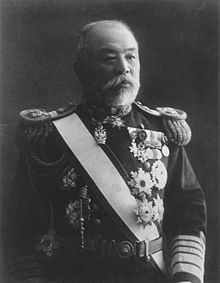Dewa Shigetō
Baron Dewa Shigetō 出羽 重遠 | |
|---|---|
 Portrait of Admiral Baron Dewa Shigetō from National Diet Library, Tokyo, | |
| Born | 10 December 1856 Aizu domain, Japan |
| Died | 27 January 1930 (aged 73) Tokyo, Japan |
| Allegiance | |
| Service/ | |
| Years of service | 1878–1925 |
| Rank | |
| Commands held | Tokiwa 3rd Squadron of IJN 1st Fleet IJN 3rd Fleet, Director of the Naval Education Bureau, IJN 2nd Fleet, Sasebo Naval District, IJN 1st Fleet. |
| Battles/wars | Boshin War |
| Awards | Order of the Rising Sun, 1st Class |
Baron Dewa Shigetō (出羽 重遠, 10 December 1856 – 27 January 1930) was a Japanese admiral in the early days of the Imperial Japanese Navy.
Biography
Dewa was born as the son of a
Dewa attended the 5th class of the
During the
Promoted to
In December 1905, he was appointed
On 3 December 1907, Dewa was elevated to the peerage with the
system.Later, he was successively Commander-in-Chief of the
On 9 July 1912, he was promoted to full
On the occasion of the Siemens-Vickers Navy Armament Scandal, as Chairman of the Commission of Inquiry he concentrated his efforts on the cleanup of corruption from the Navy. This eventually led to the fall of Admiral Yamamoto Gonnohyōe's cabinet in March 1914. Dewa retired from active service in 1925.
In his later years, Dewa was involved with the construction of memorials to the casualties of the Battle of Aizu.[4] His grave is at the Aoyama Cemetery in Tokyo.
Honors
From the article in the Japanese Wikipedia
 Order of the Sacred Treasure, 4th Class
Order of the Sacred Treasure, 4th Class Grand Cordon of the Order of the Rising Sun (1 April 1906)
Grand Cordon of the Order of the Rising Sun (1 April 1906) Order of the Golden Kite, 2nd Class (1 April 1906)
Order of the Golden Kite, 2nd Class (1 April 1906)- Baron (21 September 1907)
 Grand Cordon of the Order of the Rising Sun with Paulownia Flowers (27 January 1930; posthumous)
Grand Cordon of the Order of the Rising Sun with Paulownia Flowers (27 January 1930; posthumous) Grand Cordon of the Order of the Plum Blossoms of the Korean Empire
Grand Cordon of the Order of the Plum Blossoms of the Korean Empire
References
Books
- Andidora, Ronald (2000). Iron Admirals: Naval Leadership in the Twentieth Century. Greenwood Press. ISBN 0-313-31266-4.
- Dupuy, Trevor N. (1992). Encyclopedia of Military Biography. I B Tauris & Co Ltd. ISBN 1-85043-569-3.
- Schencking, J. Charles (2005). Making Waves: Politics, Propaganda, And The Emergence Of The Imperial Japanese Navy, 1868-1922. Stanford University Press. ISBN 0-8047-4977-9.
- Warner, Denis; Warner, Peggy (1974). The Tide at Sunrise: A History of the Russo-Japanese War', 1904-1905. Charterhouse. ISBN 9780883270318.
- Yamakawa, Kenjirō (1933). Aizu Boshin Senshi. Tokyo: Aizu Boshin Senshi Hensankai.
- Yamakawa, Kenjirō; Munekawa, Toraji (1926). Hoshū Aizu Byakkotai jūkyūshi-den. Wakamatsu: Aizu Chōrei Gikai.
- Matsuno, Yoshitora; Oohashi, Kazuhiro (1992). Umi ha hakuhatsu naredo. Tokyo: Hakubunkan Shinsya.
Notes
External links
- Nishida, Hiroshi. "People of the IJN: Dewa, Shigeto". Imperial Japanese Navy.
- National Diet Library. "Dewa Shigeto".
